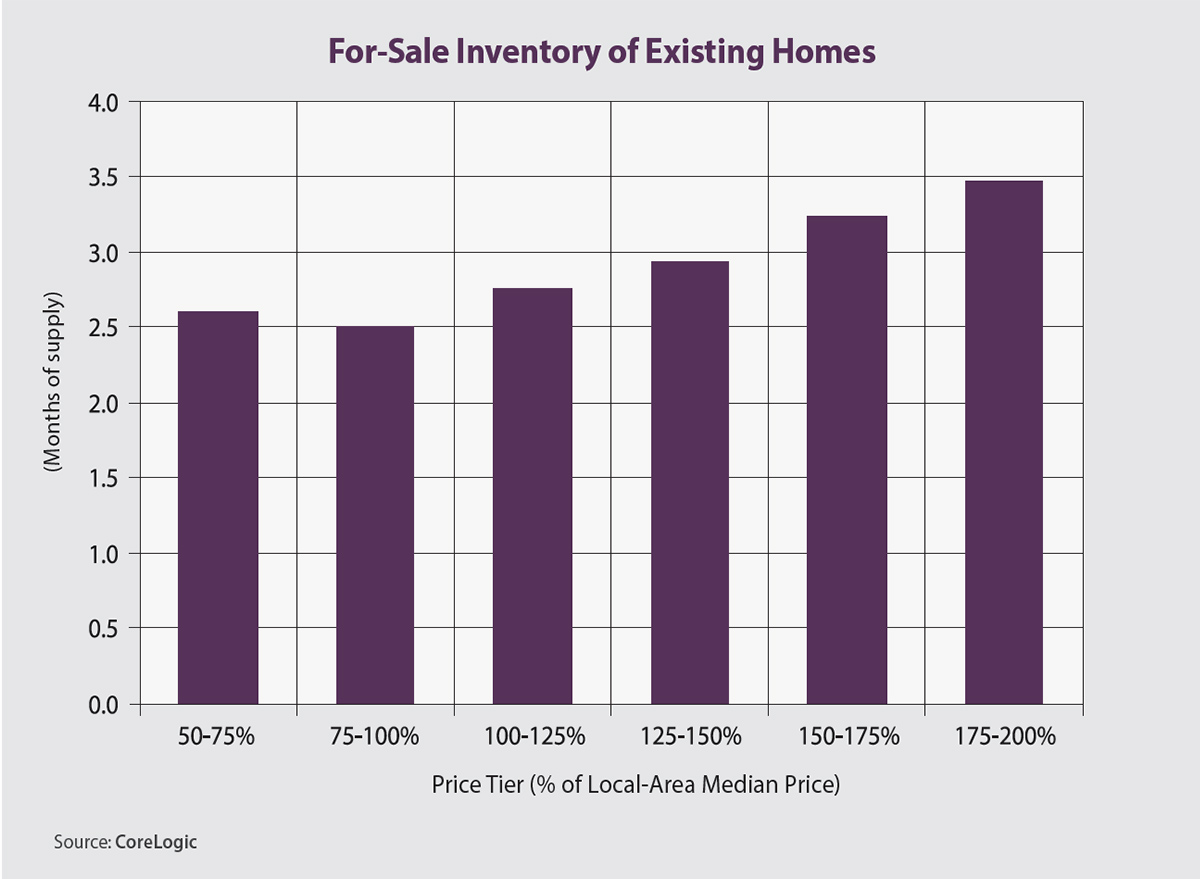The CoreLogic Home Price Index has reported a strong rebound in prices from the trough that occurred in March 2011. As of this past July, the national index had increased by 62% from its nadir, with lower-priced homes experiencing even faster appreciation.
When comparing homes that are priced at least 25% below their local market’s median price and homes priced at least 25% above the median, the least-expensive homes have had cumulative price growth of 96% from March 2011 through July 2019, compared to 49% growth for the most-expensive homes. This pattern has continued into the current year, too. Year to date through this past July, the least-expensive homes appreciated by 6% annually, while the most-expensive homes had 3% price growth.
Two causes of the imbalance in price growth across value tiers are reduced supply and increased demand for the lowest-priced homes. The net result of these forces are lower months-of-supply numbers for the homes in the least-expensive tiers, which are generally the properties that entry-level buyers and investors are looking to purchase. That trend is illustrated in the accompanying chart.
In part, these trends reflect demographic forces. The largest cohort of current homeowners are baby boomers, who are staying in their homes longer and thereby reducing the flow of existing homes listed for sale.
There are multiple forces contributing to these lengthier stays. Most baby boomers are in their late 50s or older, ages where household mobility tends to be low. Additionally, many boomers are living with their adult millennial-aged children, delaying any moves to sell and downsize.
Furthermore, technology and communication advances have enabled many homeowners to change jobs without having to relocate, further reducing the flow of existing homes to the sales market. Meanwhile, increasing numbers of millennials are beginning to purchase homes for the first time, accelerating demand for starter homes.
Two factors have added to the supply-and-demand imbalance for lower-priced homes. One reason is that investors represent a much larger share of buyers than in previous years, and these investors concentrate their purchases in the lower price tiers. From 1999 to 2003, for example, 10.7% of the buyers of entry-level homes were investors. This share rose to 19.2% from 2015 to 2019.
A second reason is the dearth of new construction of lower-priced homes. New homes have always carried higher price tags than existing homes, but that differential has widened since the Great Recession. From 1999 to 2003, for instance, 3.8% of entry-level sales were new construction, but from 2015 to 2019, this share fell to 1.8%. By contrast, new construction accounted for 13.3% of premium-priced home sales in recent years, helping to moderate price growth for the upper tiers.
A lack of new-home supply among the lower-priced tiers has occurred throughout the U.S. In Atlanta, Dallas, Orlando and Phoenix — four metro areas that had some of the largest numbers of new-home sales during the past year — new construction generally added to the supply of higher-priced homes by at least 20%, but it only increased the supply of lower-priced homes by about 3%. Limited supply and rising demand for lower-priced homes, relative to premium-priced homes, explains much of the difference in price growth.
Author
-

Frank E. Nothaft is chief economist for CoreLogic, America’s largest provider of advanced property and ownership information, analytics and data-enabled services. He leads the economics team responsible for analysis, commentary and forecasting trends in global real estate, insurance and mortgage markets. Before joining CoreLogic, Nothaft served as chief economist for Freddie Mac. Prior to Freddie Mac, he was an economist with the Board of Governors of the Federal Reserve System.

